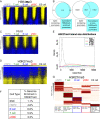Dynamic regulation of epigenomic landscapes during hematopoiesis
- PMID: 23510235
- PMCID: PMC3636055
- DOI: 10.1186/1471-2164-14-193
Dynamic regulation of epigenomic landscapes during hematopoiesis
Abstract
Background: Human blood develops from self-renewing hematopoietic stem cells to terminal lineages and necessitates regulator and effector gene expression changes; each cell type specifically expresses a subset of genes to carry out a specific function. Gene expression changes coincide with histone modification, histone variant deposition, and recruitment of transcription-related enzymes to specific genetic loci. Transcriptional regulation has been mostly studied using in vitro systems while epigenetic changes occurring during in vivo development remain poorly understood.
Results: By integrating previously published and novel global expression profiles from human CD34+/CD133+ hematopoietic stem and progenitor cells (HSPCs), in vivo differentiated human CD4+ T-cells and CD19+ B-cells, and in vitro differentiated CD36+ erythrocyte precursors, we identified hundreds of transcripts specifically expressed in each cell type. To relate concurrent epigenomic changes to expression, we examined genome-wide distributions of H3K4me1, H3K4me3, H3K27me1, H3K27me3, histone variant H2A.Z, ATP-dependent chromatin remodeler BRG1, and RNA Polymerase II in these cell types, as well as embryonic stem cells. These datasets revealed that numerous differentiation genes are primed for subsequent downstream expression by BRG1 and PolII binding in HSPCs, as well as the bivalent H3K4me3 and H3K27me3 modifications in the HSPCs prior to their expression in downstream, differentiated cell types; much HSPC bivalency is retained from embryonic stem cells. After differentiation, bivalency resolves to active chromatin configuration in the specific lineage, while it remains in parallel differentiated lineages. PolII and BRG1 are lost in closer lineages; bivalency resolves to silent monovalency in more distant lineages. Correlation of expression with epigenomic changes predicts tens of thousands of potential common and tissue-specific enhancers, which may contribute to expression patterns and differentiation pathways.
Conclusions: Several crucial lineage factors are bivalently prepared for their eventual expression or repression. Bivalency is not only resolved during differentiation but is also established in a step-wise manner in differentiated cell types. We note a progressive, specific silencing of alternate lineage genes in certain cell types coinciding with H3K27me3 enrichment, though expression silencing is maintained in its absence. Globally, the expression of type-specific genes across many cell types correlates strongly with their epigenetic profiles. These epigenomic data appear useful for further understanding mechanisms of differentiation and function of human blood lineages.
Figures







References
Publication types
MeSH terms
Substances
Grants and funding
LinkOut - more resources
Full Text Sources
Other Literature Sources
Medical
Molecular Biology Databases
Research Materials
Miscellaneous

